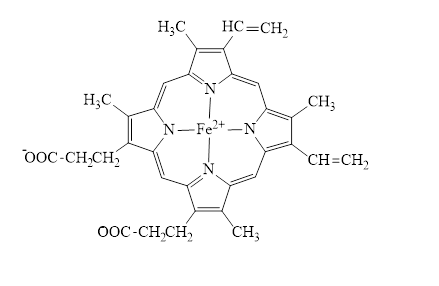
Concept explainers
Interpretation: To determine the incorrect statement concerning the bile pigments produced from the degradation of the heme portion of hemoglobin.
Concept introduction: Hemoglobin is a heme protein present in the red blood cells. The protein part is called globin and the non-protein part is heme. Heme is the prosthetic group that contains 4 pyrrole groups bonded together and has an iron atom in the center. The structure of the heme group is:

Degradation process of heme portion of hemoglobin involves two steps.
Step 1: The first step of degradation of heme involves opening of pyrrole ring with the release of the iron atom. The iron atom released becomes part of ferritin protein.

Step 2: Biliverdin produced is converted bilirubin in the spleen. Bilirubin is then transported to the liver where attachment of sugar residues to the propionate side chains of the bilirubin occurs to make it more soluble.

Then more solubilized bilirubin is excreted in bile and finally to the small intestine. In the small intestine, it is converted into stercobilin for excretion in feces or urobilin for excretion in urine.

Want to see the full answer?
Check out a sample textbook solution
Chapter 15 Solutions
Organic And Biological Chemistry
- Which of the following statements concerning the degradation of standard amino acid carbon skeletons is correct? a. Each type of carbon skeleton is degraded to a different product. b. All carbon skeletons are degraded to the same product. c. Each type of carbon skeleton is degraded by a different metabolic pathway. d. no correct responsearrow_forwardHormone-sensitive lipase needed for triacylglycerol mobilization is activated by a. epinephrine b. cAMP c. adipocytes d. no correct responsearrow_forwardThe enzymes that convert disaccharides to monosaccharides are associated with a. intestinal villi b. intestinal mucosal cells c. the pancreas d. no correct responsearrow_forward
- In the degradation of heme, the iron atom present is released and then a. eliminated from the body in the urine b. captured by the iron-storage protein ferritin c. captured by the B vitamin niacin d. no correct responsearrow_forwardWhich of the following statements concerning fibrous and globular proteins is correct? a. Fibrous proteins, but not globular proteins, are generally water soluble. b. Globular proteins, but not fibrous proteins, are generally water soluble. c. Both fibrous and globular proteins are generally water soluble. d. no correct responsearrow_forwardWhich of the following is not an organelle? a. ribosome b. lysosome c. mitochondrion d. no correct responsearrow_forward
 General, Organic, and Biological ChemistryChemistryISBN:9781285853918Author:H. Stephen StokerPublisher:Cengage Learning
General, Organic, and Biological ChemistryChemistryISBN:9781285853918Author:H. Stephen StokerPublisher:Cengage Learning Organic And Biological ChemistryChemistryISBN:9781305081079Author:STOKER, H. Stephen (howard Stephen)Publisher:Cengage Learning,
Organic And Biological ChemistryChemistryISBN:9781305081079Author:STOKER, H. Stephen (howard Stephen)Publisher:Cengage Learning,

